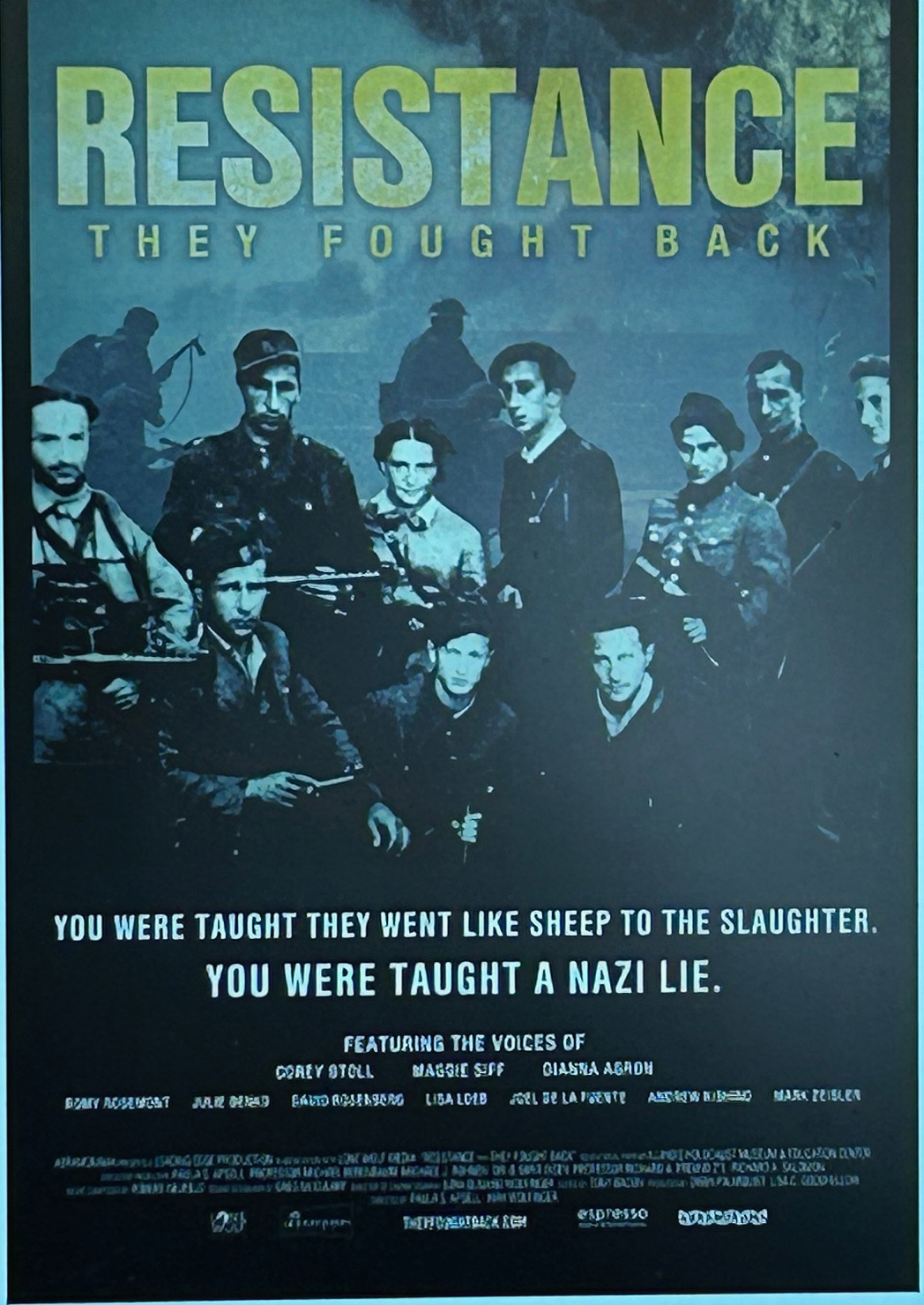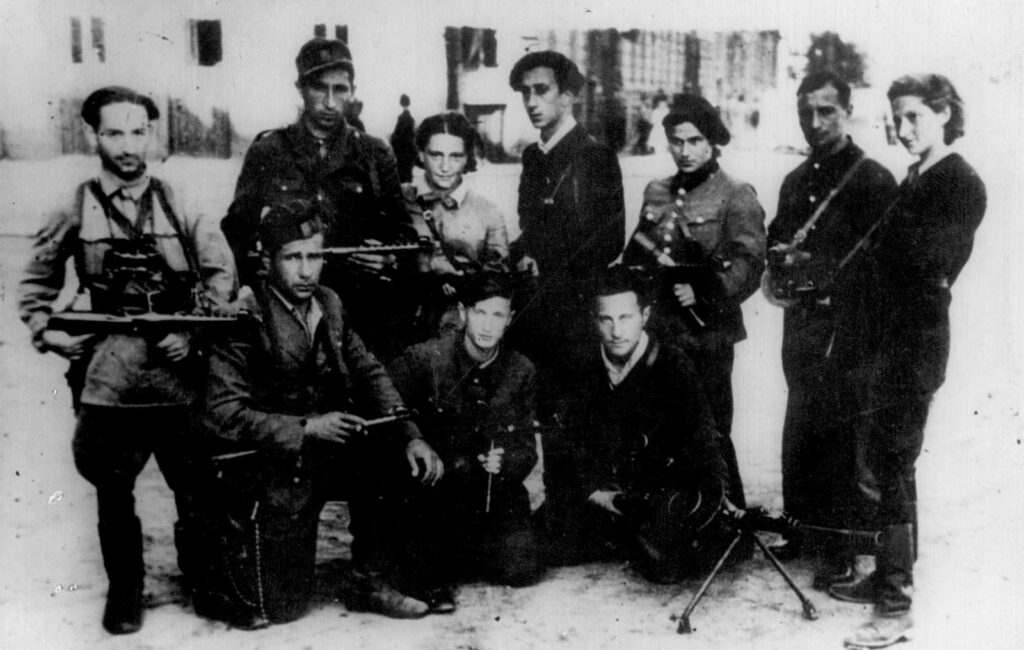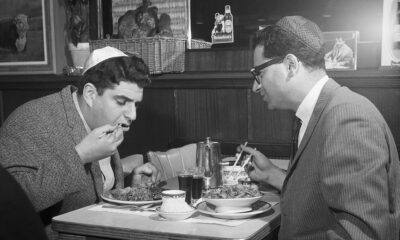Features
“Resistance: They Fought Back” – new documentary film chronicles the many instances where Jews fought back against the Nazis

By MARTIN ZEILIG “Jewish resistance during the Holocaust took many forms, armed and unarmed,” notes Holocaust scholar and archeologist Professor Richard Freund in this timely and beautifully crafted feature documentary film by directors Paula Apsell and Kirk Wolfinger.
“We’ve all heard of the Warsaw Ghetto Uprising, but most people have no idea how widespread and prevalent Jewish resistance to Nazi barbarism was. Instead, it’s widely believed Jews went to their deaths like sheep to the slaughter.”
Filmed in Poland, Lithuania, Latvia, Israel, and the U.S., Resistance – They Fought Back provides, as one of the specialists interviewed emphasizes, “a much-needed corrective to this myth of Jewish passivity.
Indeed, the film is a fervent repudiation of the thinking that Jewish resistance was either non-existent or occurred on rare occasions only.
As Dr. Margers Vestermanis, historian and resistance fighter in the Riga Ghetto, articulates, “The idea of resistance practically started with the formation of the ghetto. As we used to say in the ghetto back then, there were two options. You would be undressed…and wait for the bullet. Or you would resist, and you would be shot anyway. You would die anyway, but that would be a different death– a meaningful death, defending the honor of your people.”
There were uprisings in ghettos large and small, rebellions in death camps, and thousands of Jews fought Nazis in the forests, as is discussed in the film.

“Everywhere in Eastern Europe, Jews waged campaigns of non-violent resistance against the Nazis,” observes one of the commentators.
“All over German-occupied territories, ghetto and camp residents disobeyed German edicts to care for the sick and needy, setting up soup kitchens and educating children, maintaining a spiritual life of Jewish observance as well as a cultural life of music, art and theater, hiding and escaping, and documenting German war crimes – all this in the face of starvation, beatings, humiliation, disease, poverty, and the threat of transports and death at any time.”
Among those interviewed in the film are Professor Yehuda Bauer of Hebrew University and Yad Vashem; Professor Avinoam Patt, the inaugural director of NYU’s Center for Study of Antisemitism; and, Maurice Greenberg, Professor of Holocaust Studies in NYU’s Skirball Department of Hebrew and Judaic Studies; Professor Michael Berenbaum, an American scholar, professor, rabbi, writer, and filmmaker, who specializes in the study of the Holocaust; Steven Meed, who’s mother, Vladka Meed was a Warsaw Ghetto courier; Yoel Yaari, the son of Bela Hazan, who worked in Gestapo headquarters in Grodno. He is writing a book about her based on Bela’s own notebooks, which reveals her “courageous actions in both ghettos and camps.”
We also meet concert violinist Dana Mazurkevich, who was smuggled out of the Kovno ghetto in a truckload of potatoes; internationally known artist Samuel Bak who had his first exhibition in the Vilna Ghetto at age 9; and, David Gur, whose forgeries saved thousands of Budapest’s Jews.
This is a film that deserves the widest possible viewership.

Ms. Apsell, who was also co-writer and executive producer agreed to a Zoom interview with this reporter on April 15, 2024. (Comments from the “Director’s Statement” are also included in Ms. Apsell’s responses.)
MZ: What is the genesis of this film?
PA: It got its start on a sunny June day in 2019 at my kitchen table in Boston during a visit from Holocaust scholar and archeologist Richard Freund. In 2016, Kirk Wolfinger, his team from Lone Wolf Media, and I had made a documentary for the PBS NOVA series following Dr. Freund and his team as they discovered an underground escape tunnel in a forest in Lithuania where the Germans and their Lithuanian collaborators murdered 70,000 Jews.
As we learned when our film aired the next year, very few people had ever heard of this tunnel dug with spoons by shackled Jewish prisoners, twelve of whom escaped to fight with the partisans. But it is far from the only example of Jewish resistance during the Holocaust. When I asked why such examples of Jewish heroism were not more widely known, Dr. Freund quipped, “Because you haven’t made the film yet.”
Perhaps intended as a joke, I took the response as a challenge. I had just retired after 35 years as NOVA’s Executive Producer, and I was looking for a project to engage my mind and my heart. And what could be more worthwhile, more challenging to research and recount, than this largely unknown story of Jewish resistance during the Holocaust?
As I would learn, many stories of Jewish resistance have all but vanished. In some cases, no historical records exist, and no one survived to tell the tale. The Germans documented many aspects of their war against the Jews, but they were allergic to any mention of Jewish resistance, leading many to think it never happened and to believe that “Jews went to their deaths like sheep to the slaughter.”
MZ: What else would you like to say about the film?
PA: The film my production partners at Lone Wolf Media and I wound up making is a passionate refutation of that way of thinking (that Jewish resistance was either non-existence or rare). Told by survivors, their children, and expert witnesses from the U.S. Israel, and Europe, it is a revelation based on extensive research of how the Jews of Europe fought back.
It uncovers evidence of non-violent methods which served as crucial tools of resistance and evolved into Jewish armed revolts in ghettos, forests and death camps, even as the odds of success were vanishingly small. Today, almost eighty years after the Holocaust, this story remains largely unknown to the general public. Without it, our understanding of this genocide, which wiped out two-thirds of European Jews, remains incomplete, giving rise to renewed anti-Semitism, hatred, and denial of the Holocaust itself.
It took four years to produce the feature documentary Resistance – They Fought Back during which challenges abounded, some predictable when we began, others totally unknown.
Our society’s understanding of the Holocaust, even after all these decades, is limited, misunderstood and frighteningly transient. Surveys indicate that two-thirds of millennials in the United States cannot identify the infamous concentration camp Auschwitz. In the U.K., surveys suggest that 1 in 20 people don’t believe the Holocaust happened, and one-third of people from seven surveyed European countries know little or nothing about it.
That Jews were complicit in their own deaths has become a common meme of both anti-Semitic and white supremacy movements, which are steeply on the rise. Therefore, this story is one that demands to be told now with the authenticity that archeological finds, rigorous historical analysis, and eyewitness testimony describing tunnels that were dug, sewers used as escape routes, examples of sabotage against the all-powerful German army can provide.
Thus, even as survivors leave us and personal testimony fades, we are gaining a new perspective to our understanding of the Holocaust. It is this story of millions of victims whose brave acts of resistance against a barbaric and all-powerful enemy have too long remained unheralded, that we are determined to tell.
Features
Is This the End of Jewish Life in Western Countries?

By HENRY SREBRNIK “Globalize the Intifada” has been the chant echoing through streets since October 7th, 2023. It was never a metaphor, and we now see the gruesome results across the western world, from Australia to Canada: the rise of groups of large, active networks of Islamist and anti-Zionist organizations.
Jews in the West are discovering that the nations they defended, enriched, and profoundly shaped have become increasingly inhospitable. After the Holocaust, explicit Jew-hatred became unfashionable in polite society, but the impulse never disappeared. The workaround was simple: separate Zionism from Judaism in name, then recycle every old anti-Jewish trope and pin it on “the Zionists.”
We have seen the full legitimization of genocidal anti-Zionism and its enthusiastic adoption by large segments of the public. The protests themselves, as they began immediately on October 7th, were celebrations of the Hamas massacres. The encampments, the building occupations, the harassment campaigns against Jewish students, the open calls for intifada, the attacks on Jews and Jewish places have become our new norm. History shows us that antisemitism does not respond to reason, incentive or the honest appeals of the Jewish community.
Outside the United States, there is no Western political establishment with either the will or the capability to address this problem, let alone reverse its growth. I’m sorry to say this, but the future of Western Europe, Canada, Australia, and New Zealand is likely to be increasingly Jew-free.
Today, police stand and watch mobs chant for Israel’s destruction, call for the genocide of its people, harass visibly Jewish citizens, and drive antisemitic intimidation deep into urban life. They now believe their job is to enforce the law only if it does not risk upsetting violent constituencies. This makes Jews expendable, because defending them risks confrontation. This was very clear in the Bondi Beach massacre.
Jews are again donning caps instead of kippot, dressing generically with no cultural markers, and avoiding even a tote bag with Hebrew on it. A corrosive creep toward informal segregation in retail and service sectors is occurring, as Jewish customers report being refused service. A mezuzah hanging from a rideshare mirror leads to cancellations. When Jews express frustration, they are accused of exaggeration or attempting to suppress criticism of Israel. Jewish fear is not treated as a real problem.
“Jews Are Being Sent Back into Hiding,” the title of a Dec. 15 article in the New York Free Press by David Wolpe and Deborah Lipstadt, asserts that the attacks on Jews, including physical assaults, social media campaigns and, most tragically, the recent murders in Australia, are part of a purposive campaign designed to make Jews think twice about gathering with other Jews, entering a synagogue, going to kosher restaurants, putting a mezuzah on the doorpost of their apartments or dorm rooms, or wearing a Jewish star around their necks.
“We know of no one who would consider giving a niece, nephew, grandchild, or young friend a Jewish star without first asking permission of their parents,” they write. The unspoken, and sometimes spoken, question is: “Might wearing a star endanger your child’s well-being?”
Recently, a prominent American rabbi was entering a Target store in Chicago with her grandson, whom she had picked up from his Jewish day school. As they walked into the store the 10-year-old reached up and automatically took off his kippah and put it in his pocket. Seeing his grandmother’s quizzical look, he explained: “Mommy wants me to do that.”
Borrowing a phrase from another form of bigotry, they contend that Jews are going “back into the closet.” No public celebration of Hanukkah took place in 2025 without a significant police presence. Some people chose to stay home.
Lipstadt and Wolpe know whereof they speak. They are respectively a professor of history and Holocaust studies who served as the Biden administration’s ambassador tasked with combating antisemitism, the other a rabbi who travels to Jewish communities throughout the world, and who served on Harvard’s antisemitism task force in the aftermath of the October 7, 2023 pogrom.
What the world has seen over the past two years is a continual, often systematic attempt to terrorize Jews. When political leaders fail to condemn rather than merely “discourage” chants of “globalize the intifada,” we are seeding the ground for massacres like the Hannukah one in Sydney.
If each Jewish holiday will now be seen by antisemites as an opportunity for terror, then the prognosis for diaspora Jewry is bleak. There will be fewer public events, more alarms, more bag checks at doors; there will have to be more security and more police. Unless things change, Jewish life in the diaspora will become more sealed off from the larger society.
Why has this failure come about? Confronting antisemitism, stopping the mobs, challenging the activists, and disciplining antisemitic bureaucrats all carry electoral risk for politicians; Jews are demographically irrelevant, especially compared with Muslim voters, with the U.S. being the only partial exception.
There are those who suggest Jews stop donating funds to educational and other institutions that have turned against us. At this point, I doubt very much that withdrawing dollars will have an impact. For every dollar withdrawn, there will be 100 from Qatar and other sources in its place.
Throughout history, the way a society treats its Jews predicts its future with unerring accuracy. If Jews leave, it will be because a civilization that will not defend its Jews will also defend next to nothing and may itself not survive.
Henry Srebrnik is a professor of political science at the University of Prince Edward Island
Features
Canadian Travel Trends 2025 and the Forecast for 2026

Canadians planning to travel in 2026 should keep an eye on shifting trends and learn what’s coming their way in the new year.
Canadian travel has seen a fair amount of change and instability over the last few years, thanks mostly to the country’s southern neighbours. In 2025, and likely into 2026, travel trends in the Great White North have stabilized significantly, with more Canadians than ever choosing to travel within their own borders. And with 2026 nipping at our heels, let’s take a look at what trends in 2025 have been the most prevalent and how these will shape travellers’ decisions and travel plans in the new year.
Canadian Travel in 2025
Thanks to many factors, including politics, inflation, and airline competition, the majority of travellers opted to explore their own country rather than go abroad in 2025. More local travel money is remaining within the local economy, further bolstering it and making it an even more attractive travel choice. Thanks to the accessibility of private jet charter travel across Canada, luxury local travel has increased as well, with more people looking to immerse themselves in luxury from the start of their journey to the end. When travelling abroad, the U.S. is now the least favoured destination for most Canadian travellers, but Europe saw a significant increase in interest as 2025 progressed.
As local Canadian travel increased this year, it brought with it a drive for local tourists to find their own “Secret Canada” destinations. Far more “off the beaten path” trips were taken, resulting in more travel spending going to smaller or more boutique destinations rather than big city experiences. In 2025, travellers have sought out the wonderful diversity in destinations and landscapes, allowing themselves to access more grounded and authentically Canadian experiences.
Canada’s Government has also encouraged and benefited from local tourism, with initiatives like the Canada Strong Pass offering extra benefits. Initially implemented in the summer, but reintroduced from December 12, 2025, until January 15, 2026, this is a ticket to enjoying the richness of their own culture (iconic natural destinations, museums, train trips) at a discounted rate or even in some cases free of charge.

In the second quarter of 2025, locals took a total of 90.6 million trips that included at least some time spent travelling domestically, which indicated a rise of 10.9% on a year-over-year basis. Of these trips, 58.6 million were day trip experiences (an increase of 12.4%), and 32.0 million were overnight trips or longer (an increase of 8.4%).
Between April and June of this year, Canadian residents spent $20.3 billion on local tourism, which represented a 13.5% year-over-year increase. When undertaking day trips, Canadians spent approximately $101 per visit. On overnight trips, locals spent around $449 per trip, with an average trip length of 2.6 nights. The Great White North is clearly holding its own, and then some, in the international travel market.
Canadian Travel in 2026
As we move towards 2026, many trends from 2025 will remain the standard, but some will evolve to fit changing demands. Across the board, though, the outlook for the coming year is that Canadian travel will become a far more personal thing, with trips being customized to fit travellers’ requirements and desires more closely than ever before. From choosing a hotel that they feel smacks of a beloved destination in their favourite novel, to taking a trip to a destination just to try a snack that’s famously made there and only there, travel is stretching and shifting for the traveller rather than the other way around.
Here are some slightly more specific predictions for the coming year based on the answers of polled Canadians.

- One Gen Z-led trend is the idea of “glowmad travel”. Beauty and skincare are now influencing the places that Gen Z travels, and their trips are far more likely to include visits to skincare and beauty destinations like spas and luxury stores.
- Gen Z adults are helping to drive another trend: family travel as a way to save money. 345 of Gen Z adults polled say that they would take this route.
- More than 70% of Canadians are considering some sort of mountainous getaway in 2026, specifically in summer or autumn.
- 48% of polled Canadians say they would book or consider a destination thanks to the influence of literature.
- More travellers than ever are choosing their destinations based on the accommodations available. 44% of polled travellers say that in 2026, accommodation and what it can offer comes first, and the surrounding destination comes second.
The World Is Your Nova Scotia Lobster Roll
Choose something a little different when you vacation this year. Oysters are great, but a Nova Scotia lobster roll might be more to your taste! Canadians know good travel, so take a maple leaf out of their book and experience something new this year.
Features
Fake IDs and Underage Bettors: The Growing Problem for Sportsbooks
The expansion of legalized sports betting worldwide has resulted in sportsbooks grappling with a problem that they can no longer overlook: the increase in underage individuals using counterfeit identification to place bets. As more and more ways to bet through mobile apps and online sign-ups emerge, minors who are set on their goal are inventing ways to get around age limits. The emergence of this trend is a breach of the law and morality; however, it is also an enormous problem that threatens the very existence of the platforms, which are forced to rigorously obey the regulations .
Why Fake IDs Are Becoming More Sophisticated
Conventional fakes used to be quite simple to recognize—low-quality printing, different fonts for the text, and inconsistent holograms would make them not very reliable for any kind of verification. But counterfeit documents have changed significantly over time. Nowadays, fakes are made better with the help of printing technology and software, and they can even copy barcodes and other scannable features, so their IDs look almost real.
This fact complicates things significantly for sportsbooks, especially those operating online. Most of the time, automated identity verification systems capture a user’s photo and perform basic data matching. In cases where a very good fake ID is used by a teenager who looks older, some systems cannot recognize the trick. Therefore, young bettors have found ways to be able to place wagers through these loopholes.
The Influence of Social Pressure and Online Culture
Social media is a major factor in the increase in risky behavior that minors are engaging in. On various platforms such as Instagram, TikTok, and Reddit, teenagers come across betting slips, parlay wins, and big-payout screenshots that are shared, most probably, by other users. The glamorization of sports betting is leading young people to copy the behavior of influencers, older friends, or even celebrities, as they think that it is the right thing to do.
The competitiveness usually associated with sports is one of the reasons some minors decide to bet on sports. For many, betting becomes another way to engage as a fan—by predicting outcomes, challenging friends, and experiencing the same excitement that adult fans enjoy. Unfortunately, only a small number of minors fully understand the financial risks involved, making them more vulnerable to developing harmful patterns that could continue into adulthood. This is why choosing the most responsible sportsbook, which you can discover more here, is essential. Such platforms provide guidance, enforce safe practices, and ensure regulated play, allowing fans to engage with sports betting in a more informed, secure, and controlled manner.
Sportsbooks Facing Regulatory Pressure
The sportsbooks are being given the task of more closely monitoring and preventing minors from betting on their platforms. If they fail, harsh penalties are possible, including severe fines, loss of a gambling license, and negative publicity that undermines a brand’s trustworthiness. As a result, it is becoming increasingly difficult for people to verify their identities, although this also inconveniences those who are, in fact, legitimate users.
Sportsbooks have to decide between two options that are in conflict with each other: on the one hand, they have to keep the registration process as simple as possible, and on the other hand, they have to carry out age verification in a very thorough manner. The work of balancing is tough, and the underage gamblers are trying all methods to find a way out.
The Rise of Identity Fraud Services
An alarming trend is the emergence of online vendors who openly advertise fake IDs and identity documents. These vendors often claim their products can pass standard sportsbook checks. Some even tailor IDs to specific regions, knowing that certain provinces, states, or countries use verification systems that rely heavily on image comparison rather than live validation.
The availability of these fraudulent services not only empowers minors but also exposes sportsbooks to risks related to stolen identities, money laundering flags, and fraudulent accounts that may later become legal liabilities.
The Consequences for Underage Bettors
While a minor might think that gambling is just a bit of fun without any harm, the outcome can be quite serious. If there is a catching, accounts are closed right away, winnings are confiscated, and parents or guardians, in some cases, are made legally liable for any financial disagreements. Besides that, the risk of developing a gambling problem in the future increases with early exposure to gambling, especially since teenagers are more impulsive and less capable of handling financial risks.
The majority of minors are not aware that sportsbooks keep very detailed records of their activities, including device information and IP addresses. In case a fake ID works one time, using it multiple times will definitely lead to getting caught.
A Growing Problem That Requires Joint Action
Fake IDs and underage betting are issues that have become a major challenge in the industry, and no single stakeholder can solve these problems on their own. Sportsbooks need to enhance their identity verifications, regulators should get prepared for new types of fraud, technology providers have to come up with new solutions more quickly, and parents should always be aware of what their children are doing online. The industry’s rapid development is making this problem more and more urgent because the number of minors trying to get around the safety measures is increasing.
Sports betting can serve as a fun and legal form of entertainment for adults, but the need to protect the youth is what defines the industry and ensures its survival in the long run. As the quality of fake IDs keeps improving and the online culture is more and more inclined to consider betting as a normal activity, sportsbooks must ensure that underage users do not have access and that the environment is safe for all users. They need to do this now more than ever.





